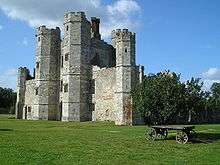Henry Bentinck, 1st Duke of Portland
Henry Bentinck, 1st Duke of Portland (17 March 1682 – 4 July 1726), of Titchfield, Hampshire, styled Viscount Woodstock from 1689 until 1709, was a British Whig politician who sat in the English and British House of Commons from 1705 until 1709 when he succeeded to the perage as Earl of Portland. He was Governor of Jamaica from 1721 to 1726.
His Grace The Duke of Portland | |
|---|---|
| Member of Parliament for Southampton | |
| In office 1705–1708 | |
| Member of Parliament for Hampshire | |
| In office 1708–1709 | |
| Governor of Jamaica | |
| In office 1721–1726 | |
| Personal details | |
| Born | 17 March 1682 |
| Died | 4 July 1726 (aged 44) Spanish Town, Jamaica |
| Resting place | Westminster Abbey |
| Nationality | English |
| Political party | Whig |
| Spouse(s) | Lady Elizabeth Noel |
| Children | 7, including William and George |
| Parents | William Bentinck, 1st Earl of Portland Anne Villiers |
Early life
Bentinck was the second, but eldest surviving, son of William Bentinck, 1st Earl of Portland, and his wife Anne née Villiers. His mother was from the Villiers family, the eldest daughter of Sir Edward Villiers and sister of Edward Villiers, 1st Earl of Jersey. From 1702 to 1703, Bentinck did the Grand Tour around Europe, travelling through Italy and Germany with his tutor, the historian Paul de Rapin. On 9 June 1704, he married Lady Elizabeth Noel, daughter of Wriothesley Baptist Noel, 2nd Earl of Gainsborough and Catherine Greville at Chiswick, an heiress with a fortune of £60,000, who brought him the estate of Titchfield in Hampshire.[1]
Career

At the 1705 English general election, Bentinck was returned in a contest as Whig Member of Parliament for Southampton. Apart from carrying out minor functions, he appears to have been inactive in Parliament. At the 1708 British general election, he was returned unopposed for Southampton and in a contest at Hampshire, and opted to sit for Hampshire. He acted as a teller for the Whigs. He succeeded his father as Earl of Portland on 23 November 1709 and vacated his seat in the House of Commons to sit in the Lords. He now owned the principal family seat of Bulstrode in Berkshire, and also inherited estates worth about £850,150 in Cheshire, Cumberland, Hertfordshire, Norfolk, Sussex, Westminster and Yorkshire, In 1710, he was appointed Colonel of the 1st Troop of Horse Guards until 1713. He was created Marquess of Titchfield and Duke of Portland on 6 July 1716.[1] In 1719 he was one of main subscribers in the Royal Academy of Music (1719), a corporation that produced baroque opera on stage.[2] He was appointed Lord of the Bedchamber in 1717 and held the post for the rest of hislife.
Portland lost a huge amount of money in the South Sea Bubble in 1720. In 1721, he accepted the post of Governor of Jamaica,[1] which was a lucrative but not a very prestigious post, and one with a low survival rate.
Death and legacy
Portland died in Jamaica at Spanish Town on 4 July 1726, aged 45, and his body was returned to England for burial. He was interred on 3 November 1796[3] in Westminster Abbey in the vault of the Dukes of Ormond located in the King Henry VII Chapel. Portland and his wife had three sons and seven daughters,[1] who included
- William Bentinck, Viscount Woodstock, later Marquess of Titchfield, later 2nd Duke of Portland (1709–1762)
- Lord George (1715–1759), soldier
- Lady Anne (d. 1749), married Col. Daniel Paul
- Lady Amelia Catharina (d. 1756), married Jacob van Wassenaer, Heer van Hazerswoude-Waddingsveen
- Lady Isabella (d. 1783), married Henry Monck, uncle of Charles Monck, 1st Viscount Monck; their daughter Elizabeth married the 1st Marquess of Waterford.[2]
References
- "BENTINCK, Henry, Visct. Woodstock (c.1682-1726), of Titchfield, Hants". History of Parliament Online.
- "Biography of [William] Henry Bentinck, 1st Duke of Portland (1682-1726)". University of Nottingham.
- Chester, Joseph (1876). The Marriage, Baptismal, and Burial Registers of the Collegiate Church or Abbey of St. Peter, Westminister. London. p. 319.
External links
| Parliament of England | ||
|---|---|---|
| Preceded by Adam de Cardonnel Frederick Tylney |
Member of Parliament for Southampton 1705–1707 With: Adam de Cardonnel |
Succeeded by Parliament of Great Britain |
| Parliament of Great Britain | ||
| Preceded by Parliament of England |
Member of Parliament for Southampton 1707–1708 With: Adam de Cardonnel |
Succeeded by Adam de Cardonnel Simeon Stewart |
| Preceded by Thomas Jervoise Richard Chaundler |
Member of Parliament for Hampshire 1708–1709 With: Marquess of Winchester |
Succeeded by Marquess of Winchester Thomas Jervoise |
| Military offices | ||
| Preceded by The Earl of Albemarle |
Captain and Colonel of His Majesty's Own Troop of Horse Guards 1710–1713 |
Succeeded by The Lord Ashburnham |
| Government offices | ||
| Preceded by Sir Nicholas Lawes |
Governor of Jamaica 1722–1726 |
Succeeded by John Ayscough (acting) |
| Peerage of Great Britain | ||
| New creation | Duke of Portland 1716–1726 |
Succeeded by William Bentinck |
| Peerage of England | ||
| Preceded by William Bentinck |
Earl of Portland 1709–1726 |
Succeeded by William Bentinck |